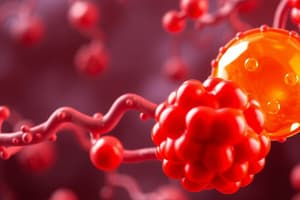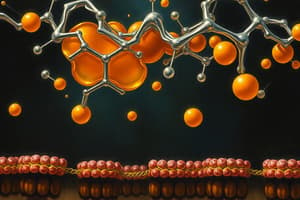Podcast
Questions and Answers
What is the primary effect of insulin on HMG-CoA reductase activity?
What is the primary effect of insulin on HMG-CoA reductase activity?
- Reduces enzyme synthesis in the nucleus
- Decreases activity through proteolytic degradation
- Increases activity through dephosphorylation (correct)
- Increases phosphorylation of the enzyme
How does SREBP regulate cholesterol metabolism when sterol levels decline?
How does SREBP regulate cholesterol metabolism when sterol levels decline?
- High levels of sterol induce SREBP degradation
- SREBP remains in the ER with Insig and SCAP
- Insig promotes the phosphorylation of SREBP
- SREBP is cleaved and activates HMG-CoA reductase transcription (correct)
What triggers the degradation of HMG-CoA reductase by proteasomes?
What triggers the degradation of HMG-CoA reductase by proteasomes?
- Binding of AMPK to the enzyme
- Phosphorylation by glucagon
- Ubiquitination initiated by Insig binding to oxysterol (correct)
- Inhibition by malonyl-CoA
Which statement about AMPK is true?
Which statement about AMPK is true?
What effect does metformin have on AMPK?
What effect does metformin have on AMPK?
What molecule is the precursor to triacylglycerols (TAGs) and phospholipids?
What molecule is the precursor to triacylglycerols (TAGs) and phospholipids?
What is the role of HMG-CoA reductase in cholesterol biosynthesis?
What is the role of HMG-CoA reductase in cholesterol biosynthesis?
Which metabolite is formed when phosphatidic acid undergoes the action of lipin?
Which metabolite is formed when phosphatidic acid undergoes the action of lipin?
What structural feature distinguishes steroids from other lipid types?
What structural feature distinguishes steroids from other lipid types?
How do statin drugs function in cholesterol regulation?
How do statin drugs function in cholesterol regulation?
Which factor positively regulates HMG-CoA reductase activity?
Which factor positively regulates HMG-CoA reductase activity?
What is the first step in the process of eukaryotic cholesterol biosynthesis?
What is the first step in the process of eukaryotic cholesterol biosynthesis?
Which regulatory mechanism does NOT affect HMG-CoA reductase?
Which regulatory mechanism does NOT affect HMG-CoA reductase?
What occurs when sterol levels decline in relation to SREBP?
What occurs when sterol levels decline in relation to SREBP?
What role does Insig play in the regulation of HMG-CoA reductase?
What role does Insig play in the regulation of HMG-CoA reductase?
What happens to SREBP when sterol levels are high?
What happens to SREBP when sterol levels are high?
Which statement accurately describes the function of HMG-CoA reductase?
Which statement accurately describes the function of HMG-CoA reductase?
Which condition leads to the proteolytic degradation of HMG-CoA reductase?
Which condition leads to the proteolytic degradation of HMG-CoA reductase?
Flashcards
Glucagon and Epinephrine's effect on HMG-CoA Reductase
Glucagon and Epinephrine's effect on HMG-CoA Reductase
Glucagon and epinephrine lead to the phosphorylation and decreased activity of HMG-CoA Reductase via signaling cascades.
Insulin's effect on HMG-CoA Reductase
Insulin's effect on HMG-CoA Reductase
Insulin leads to dephosphorylation and increased activity of HMG-CoA Reductase through signaling cascades.
SREBP and Insig's role in cholesterol regulation
SREBP and Insig's role in cholesterol regulation
SREBPs and Insigs regulate cholesterol levels by sensing sterol levels and controlling HMG-CoA reductase transcription and degradation.
AMPK's role in fatty acid metabolism
AMPK's role in fatty acid metabolism
Signup and view all the flashcards
AMPK regulation by Metformin
AMPK regulation by Metformin
Signup and view all the flashcards
Synthesis of Triglycerides (TAGs)
Synthesis of Triglycerides (TAGs)
Signup and view all the flashcards
Phosphatidic Acid (PA)
Phosphatidic Acid (PA)
Signup and view all the flashcards
Cholesterol Synthesis
Cholesterol Synthesis
Signup and view all the flashcards
HMG-CoA Reductase
HMG-CoA Reductase
Signup and view all the flashcards
Mevalonate
Mevalonate
Signup and view all the flashcards
Statin Drugs
Statin Drugs
Signup and view all the flashcards
Covalent Modification of HMG-CoA Reductase
Covalent Modification of HMG-CoA Reductase
Signup and view all the flashcards
AMP-activated Protein Kinase (AMPK)
AMP-activated Protein Kinase (AMPK)
Signup and view all the flashcards
SREBPs and Cholesterol Levels
SREBPs and Cholesterol Levels
Signup and view all the flashcards
Insig's Role
Insig's Role
Signup and view all the flashcards
HMG-CoA Reductase: Rate-Limiting Step
HMG-CoA Reductase: Rate-Limiting Step
Signup and view all the flashcards
Ubiquitination of HMG-CoA Reductase
Ubiquitination of HMG-CoA Reductase
Signup and view all the flashcards
SREBPs and HMG-CoA Reductase
SREBPs and HMG-CoA Reductase
Signup and view all the flashcards
Study Notes
Course Information
- Final exam: Tuesday, December 10th, 8:30 AM - 10:30 AM in THRN 1307
- Course review: Friday, December 6th
Lipid Synthesis
- Two types of lipids stored in the body: triglycerides and cholesterol
- Synthesis of triglycerides (TAGs): begins with phosphatidic acid (PA) from glycerol-3-phosphate (G3P). Fatty acids are then attached to the glycerol backbone by acyltransferases, releasing CoA. TAGs consist of 3 fatty acids and glycerol
Cholesterol, Steroids, and Isoprenes
- Chemically related; all originate from isoprene units
- Distinct from triglycerides, phospholipids, and sphingolipids
- Built on biosynthesis using a 5-carbon isoprene unit
Overview of Eukaryotic Cholesterol Biosynthesis
- Three acetyl-CoA condense to form mevalonate
- Mevalonate is converted to a phosphorylated 5-carbon isoprene
- Six isoprenes polymerize to form the 30-carbon linear squalene
- Squalene cyclizes to form the four rings that are modified to produce cholesterol
Formation of Mevalonate from Acetyl-CoA
- Three acetyl-CoA molecules condense to form hydroxymethylglutaryl-CoA (HMG-CoA)
- HMG-CoA is reduced to form mevalonate
- HMG-CoA reductase is a common target for cholesterol-lowering drugs
Steroid Hormones Derived from Cholesterol
- Cholesterol is a precursor to various hormones
- Cortisol (glucocorticoid) affects protein and carbohydrate metabolism, and suppresses the immune response
- Corticosterone (mineralocorticoid) regulates the absorption of sodium, chloride and bicarbonate in the kidney
- Testosterone and estradiol are male and female sex hormones, respectively influencing secondary sexual characteristics and regulating reproductive cycles
Statin Drugs Inhibit HMG-CoA Reductase
- Statins resemble mevalonate, which are competitive inhibitors of HMG-CoA reductase
- First statin, lovastatin, was found in fungi
- Statins lower serum cholesterol by a significant percentage
- Statins lower cholesterol biosynthesis, since, cholesterol is a precursor for some hormones
Modes of Regulation of Cholesterol Synthesis
- Covalent modification of HMG-CoA reductase
- Transcriptional regulation of HMG-CoA reductase gene
- Proteolytic degradation of HMG-CoA reductase
AMP-activated protein kinase (AMPK) in the regulation of cholesterol
- AMP-activated protein kinase (AMPK) inactivates HMG-CoA reductase when AMP/ATP ratio rises.
- In response to low energy and high AMP levels, AMPK is activated, leading to the phosphorylation and inactivation of HMG-CoA reductase. This results in decreased cholesterol synthesis
- Glucagon and epinephrine signaling lead to a cascade that results in the activation of AMPK by phosphorylation and subsequent cholesterol synthesis reduction. Conversely, insulin promotes glycogen synthesis and increases insulin sensitivity, leading to de-phosphorylation. This results in AMPK inactivation and activation of cholesterol synthesis.
- AMP-dependent protein kinase (AMPK) is activated when AMP levels rise and phosphorylates HMG-CoA reductase, thereby reducing its activity and decreasing cholesterol synthesis. Glucagon and epinephrine signaling increase AMPK activity through phosphorylation. Insulin signaling promotes the dephosphorylation of AMPK, increasing activity and thus, cholesterol.
Regulation of HMG-CoA Reductase by Proteolytic Degradation
- Insig (insulin-induced gene protein) senses cholesterol levels. When cholesterol levels are high, Insig binds oxysterols, triggering ubiquitination of HMG-CoA reductase. This targets the enzyme for degradation by proteasomes.
Regulation of Cholesterol Metabolism
- Acetyl-CoA is converted to β-hydroxy-β-methylglutaryl-CoA (HMG-CoA) and subsequently to mevalonate
- The synthesis of mevalonate can be regulated by hormones such as insulin (stimulates) and glucagon/epinephrine (inhibits)
Fatty Acid Metabolism
- AMPK inhibits acetyl-CoA carboxylase (ACC), reducing malonyl-CoA levels, and this removes the inhibition of fatty acid oxidation.
- This allows for a faster rate of fatty acid oxidation when energy demands are high.
AMPK as a global regulator of energy metabolism
- AMPK is an energy sensor; its activity increases when ATP levels decrease and AMP levels increase
- AMPK regulates diverse metabolic pathways, including fatty acid synthesis, cholesterol synthesis, glycogen synthesis, and protein synthesis
- AMPK is a global metabolic regulator
- Its activity is regulated by factors responsive to ATP levels, exercise, hormones (e.g. insulin, glucagon) and other physiological signals
AMPK as a target for treatment of type II diabetes
- Metformin inhibits mitochondrial respiratory chain complex I and activates AMPK. Elevated AMPK signaling leads to increased fatty acid oxidation, reduced hepatic glucose production, decreased cholesterol synthesis and improved insulin sensitivity.
Studying That Suits You
Use AI to generate personalized quizzes and flashcards to suit your learning preferences.
Related Documents
Description
This quiz covers the synthesis pathways of lipids, focusing on triglycerides and cholesterol. It includes details on how triglycerides are formed from phosphatidic acid and the biosynthesis of cholesterol from acetyl-CoA. Test your understanding of these crucial metabolic processes.




